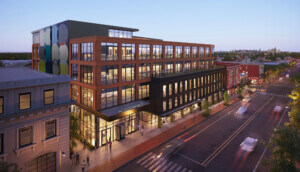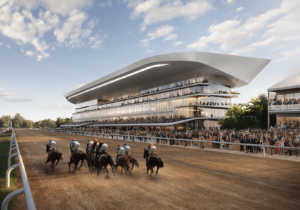The St. Louis Cardinals National League baseball team is leading the way in reimagining the sporting-event experience. Phase one of Ballpark Village, completed spring 2014, was the mixed-use development surrounding the team’s Busch Stadium called Ballpark Village. After the success of this $100-million project, the team and the city are preparing to begin the second, more ambitious phase of the plan.
With planning and design led by Denver-based architecture firm Hord Coplan Macht, Ballpark Village II will include residential, retail, hospitality, and office spaces. The development will consist of a pavilion with a 10,000-square-foot public market; a 29-story residential high-rise with 300 units looking directly into the stadium; 15,000 square feet of retail at its base; and a 10-story mixed-use building on the westernmost portion with 100,000 square feet of office space, 200 hotel rooms, and ground floor retail. The office space will be the first new Class A office tower to be built in St. Louis since 1989.
The development team plans to use the taxes generated by the phase one Ballpark Village project itself, in addition to private equity and debt investments, to finance $220-million Ballpark Village II.
Currently, the project is waiting for the city to review a bill that would amend the existing development agreement, allowing the developers to pursue their latest, more ambitious plan, which includes the new residential and office towers.
Mixed-use projects around new and old stadiums have become popular in cities hoping to attract year-round attendance to areas formerly used only for sporting events. Development of new offices, hotels, residential, and entertainment venues around the Chicago Cubs’ Wrigley Field is well underway. Detroit’s Little Caesars Arena, currently under construction, will be part of the redeveloping 50-block District Detroit. The arena will be the centerpiece of planned neighborhoods that will include six theaters; retail, residential, and office spaces; and three sports venues. A similar development and stadium for the Texas Rangers has been approved in a ballot initiative and will cost an estimated $1 billion.
Though these more recent projects may be more ambitious in scale, there is no doubt that phase one of Ballpark Village is being used as a model—with an estimated $50 million in revenue in 2015, it has been deemed a major success. The next phase hopes to continue this success with the expanding of programs on the site. While the initial phase included mostly sports-related spaces, the new development will bring the Ballpark Village closer to being an actual village, and soon enough, Cardinals fans will be able to watch live games from their living rooms, maybe even in their bathrobes.
This article appears on HoverPin, a new app that lets you build personalized maps of geo-related online content based on your interests: architecture, food, culture, fitness, and more. Never miss The Architect’s Newspaper’s coverage of your city and discover new, exciting projects wherever you go! See our HoverPin layer here and download the app from the Apple Store.










